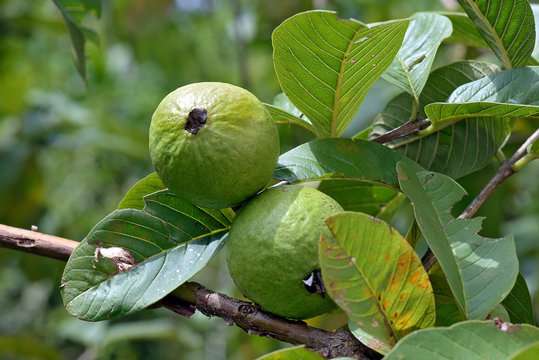The sweet-smelling tropical fruit guava is one that not many people are familiar with. However, i am all too familiar with them.

Guavas remind me of so many happy memories. We had a guava tree in our backyard when i was a child. I used to climb it all the time with my siblings and friends.
We enjoyed picking the fruits and snacking on them while debating what game to play next. Because of this, just one sniff or bite of it conjures up pleasant childhood memories.
It has such a distinctive flavor and is deserving of all the fame that other fruits enjoy. So, if you’re curious about what guava tastes like, try this.
Today is the day you learn everything there is to know about guava, including its definition, many varieties, aroma, texture, and flavor, as well as uses and how to store it properly. It’s guava be enjoyable!
Guava? What is this?
The myrtle family tree that bears the small, oval fruit. Only tropical and subtropical conditions support the growth of the tree. Only florida, hawaii, the virgin islands, and a few locations in texas and california will have it, for this reason.
Guavas come in a variety of varieties, each with unique qualities. For instance, some fruitscan grow to the size of a melon, while others can be as little as a lemon.
All varieties are green when unripe, but as they ripen, they change color. While some are pink and red, some are yellow and orange.
• When ripe, the tropical pink guava’s skin is a vivid golden color.
• When mature, the tropical yellow or mexican cream turns creamy white and has a lovely pinkish hue inside.
• The tropical white has white skin and yellow flesh, just like the mexican cream.
• The red malaysian has red skin and pink flesh. On the interior, though, it appears yellowish-red.
• The lemon guava is much smaller than other varieties, and is most frequently used as an ornament because of its distinctive appearance. On the inside as well as the outside, it has a yellow color.

What taste does guava have?
I’ll do my best to describe the fruit’s distinct flavor even if it’s difficult to do so. Ripe fruits typically taste sweet and floral and have a crisp, gritty, and pear-like feel.
Some claim it is a hybrid of a pear, a mango, and a strawberry, while others claim it is a cross between a pear and a grapefruit. It’s tasty, in my opinion.
Oh, and the aroma is really wonderful. Its perfume grows more strong as it ripens.
Although you can eat it when it’s not ripe, the flavor and texture are very different; the unripe fruit has tough skin and acidic, sour flavor. Nevertheless, it wasn’t so tough that you couldn’t bite into it.
A guava’s level of sweetness varies depending on its type. A quick comparison is shown below:
• The tropical pink has a very potent aroma and a moderately sweet flavor. It might have a smooth or a rough texture.
• The tropical yellow is the sweetest.
• The tropical white has a mushy consistency because it has more liquid than other varieties, yet it tastes like most guavas and is primarily used as an ingredient in desserts.
• There is a slight sweetness to the red malaysian as well.
• The lemon guava has a very powerful lemon aroma and a delicate mix of sweet and tart, but once more, it is most frequently employed as decoration.
No of the variety, you need to handle the seeds with care. They are edible, however they could be hard. Although they are little, you can still avoid them. Therefore, it is up to you whether you wish to consume them or avoid them.
Guava’s health benefits
Good news! The sweet fruit is very nutritious.
Here are some noteworthy dietary facts:
• Consuming guava may help reduce blood sugar levels, according to certain research.
• It is rich in potassium and antioxidants, can help with heart health.
• They are high in fiber (12% of the daily necessary amount), which can help with digestion.
• They are high in vitamin c, which helps to strengthen the immune system.

What is the way to tell when guava is ripe?
Here’s another telling sign that your guava has matured, in addition to the obvious change in color that i already mentioned: the smell. Guavas have a delicious aroma that intensifies as they develop further.
Additionally, you can tell by the texture. The flesh will be almost as sensitive as papaya and the skin will be softer.
Choosing ripe guava
As guava ripens, its color changes from a bright green to a lighter yellow-green shade, perhaps with a trace of pink. When squeezed, ripe fruit should yield slightly. It should also have a distinct, musky, sweet aroma that you can detect before even lifting it to your nose. Make sure the fruit is free of blemishes or bruises and that it is fully ripe. If the only fruits available are green and unripe, you can purchase them and ripen them at home.
What guavas are available for eating?
Guavas are edible in their entirety, including the peel, seeds, and flesh. Some people prefer to remove the seeds and rind, leaving only the luscious meat, but eating the entire guava provides much more nutrition. Just be sure to thoroughly rinse the rind to get rid of any wax.
If you simply want to consume the succulent flesh, you may discard the chewy seeds and use them in other recipes. When used in salads or as an ice cream topping, guava seeds are delicious. Additionally, they can be processed in a food processor and added to juices and smoothies.
Which way is best to store guava?
The best way to store guavas depends on the stage of ripening they are at. Allow them to ripen on the counter for a few days if they’re still firm.
However, if you want things to go more quickly, put it in a paper bag with an apple or a banana. The close closeness will hasten the maturity of your guava because these fruits release ethylene, a natural ripening agent.
As soon as your fruit reaches peak ripeness, put it in a plastic or paper bag and keep it in the crisper drawer of your refrigerator. It won’t come into contact with other fruits because of the bag, which will stop it from ripening any more. However, do not store it in the fridge for too long as it has a short shelf life. Eat it within 4 days, please.
Try freezing them if you want to preserve it for a longer period of time! But it’s a little difficult. You must first make a basic syrup and peel the guavas. After that, put it in an airtight container and cover them completely with simple syrup. Enjoy for up to a year after freezing.

Guava’s best ways to eat
The guava is a fruit with several uses. It can be used and eaten in a variety of ways. You are free to consume it exactly as is, like i do, including the skin, seeds, and everything.
But you may also add it to savory and sweet foods, as well as drinks. You can try some of the fun suggestions below:
• To improve the flavor of raw guava, try adding some salt on top. Just make sure to rinse it thoroughly, please. Before chewing into it, be sure there are no worms! Remember to inspect quickly because worms adore raw guavas.
• Juice, anyone? This is a great option for youngsters because it’s not just delicious but also really healthy. To get that incredibly sweet guava flavor, simply juice it. The blender also functions. After blending, simply strain the pulp.
• For the grownups, try this cool mint drink! Juice, mint, tequila, and lime juice are all that are required.
• Or how about a guava jam that is obscenely flavorful? Every form of bread goes great with this spread, including crackers, bagels, and toast. Additionally, try it with peanut butter for a delicious pb&j!
• Fruit is delicious in salads as well! Simply cut the fruit into slices and add it to your preferred mix.
• Or why not add ripe fruit slices to your ice cream or sundae to give it a tropical flair? Delicious.
I hope you’ve found what you’re looking for. Have a wonderful day and thanks for reading!
Khoa Pham
